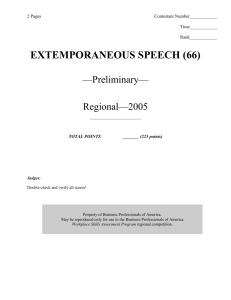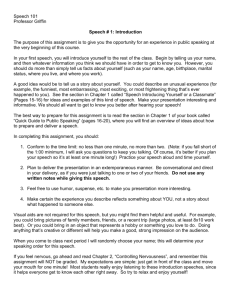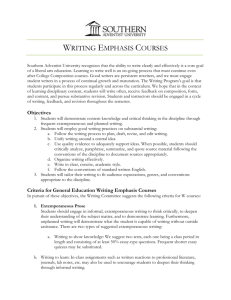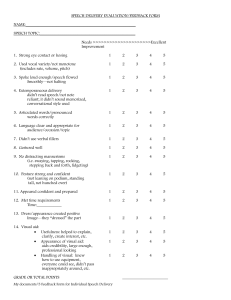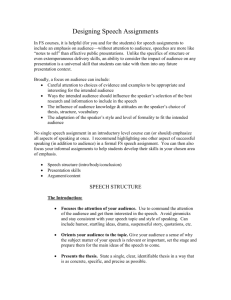Leadership Development
advertisement
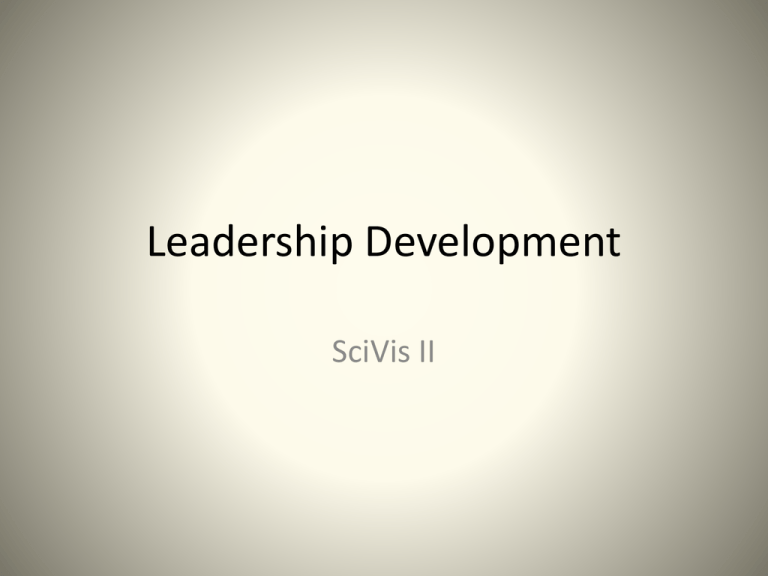
Leadership Development SciVis II Objectives • V201. Demonstrate oral communication and job seeking skills. • V201.01 Explain how to deliver an extemporaneous technical presentation. • V201.02 Deliver an extemporaneous technical presentation. • V201.03 Explain how to complete a letter of application, a job application, and a job interview. Essential Question: • How can we prepare for delivering an extemporaneous technical presentation, and have the job skills we need for our future? Extemporaneous technical presentation. Use an introduction to get the speech going. Humor may be used in the introduction. Reasons for a good introduction are to: 1. Get the audience’s attention; 2. Introduce your topic; 3. Show the importance of your topic; 4. Present your facts; and 5. Forecast your main ideas. Extemporaneous technical presentation. Do not try and memorize what you will say Trying to memorize will only make you nervous, and you will find yourself thinking about the words and not about the message. Use non-verbal communication. Step forward after the introduction. Take a few steps when you start a new point. Remember to use hand gestures. Do not put your hands in your pockets. Extemporaneous technical presentation. Start off with a strong opening idea with confidence. Then try and organize your ideas in your head. If you know you have three points or ideas to say, just start off simple by saying, "I would just like to talk about 3 points." The first point is... the second point is... and so on. Extemporaneous technical presentation. Decide on your transitions from one idea to the next. If you have more than one point to make, you can use a natural transition such as, "My second point is... or my next point is..." Maintain eye contact with the audience. Look down at your next idea or thought and then regain eye contact with your audience. Extemporaneous technical presentation. Speak clearly and with good volume. Be articulate. Remember the element of time is important in a speech. Have a good conclusion. You can summarize your basic points if needed. Reasons for a conclusion are to: 1. Inform the audience you are about to close; 2. Summarize and recap your major ideas; and 3. Leave your audience with specific ideas about your topic. Extemporaneous technical presentation. Remember these points: Do not have chewing gum. Stand up straight. Use visual aids and examples. Make sure the points support the goal and purpose of speech. Organizational forms for a speech. Topical – Most common organizational pattern, which can present more than one topic in an ordered fashion. Useful for informative and entertaining speeches. Organizational forms for a speech. Chronological – Uses a time sequence for the framework of the speech. It can also be used for informative and persuasive speeches, both of which require background information Organizational forms for a speech. Spatial – Organizes material according to physical space. It can be used for informative and entertaining physical space topics. Organizational forms for a speech. Classification – Puts items into categories in a speech. Organizational forms for a speech. Problem/Solution – Uses the first part of the speech to present the problem and the second part to present the solution. Can also be used for persuasive speeches. Organizational forms for a speech. Cause/Effect – Uses the first part of the speech to outline the cause and the second to describe the effect, and finally the last part to describe a possible solution. Your Task Practice delivering extemporaneous technical presentations. This activity will take about 2 days. Materials: • Research media such as the Internet • Materials for visuals Requirements 1. You should work independently. 2. Select a scientific topics and/or speech type of your interest. 3. You will research (no more than ½ to 1 day researching topic). 4. Use your time wisely to gather your thoughts and prepare quick visuals. 5. You will present your topics in a 3-5 minute speech. Assessment: Correct use of time 10 points Introduction and conclusion 20 points Eye contact and positive body language 10 points Coverage/accuracy of the material 30 points Voice tone and transitions 20 points Total 100 points Due date and rubric • This assignment is due to be presented on Monday: 1-27-’14 • Ms. Vasili will hand out the rubric.
